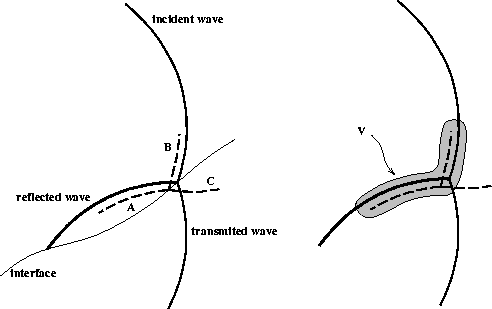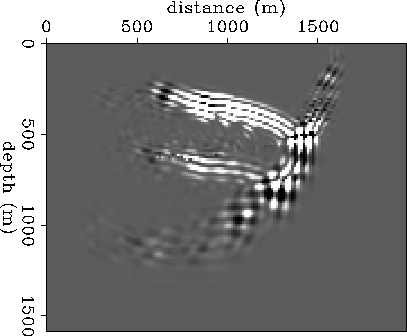 |
Figure 5 Right: The continuous thick line represents the modeled wavefield
![[*]](http://sepwww.stanford.edu/latex2html/cross_ref_motif.gif) shows the modeled wavefield and the reverse
propagated recorded field at the same time. Not only the incident
wavefield is reflected and transmitted (only the P wave component is shown)
but also the backward-propagated recorded wavefield.
shows the modeled wavefield and the reverse
propagated recorded field at the same time. Not only the incident
wavefield is reflected and transmitted (only the P wave component is shown)
but also the backward-propagated recorded wavefield.
 |
The difference is that, because of its limited aperture, the reflections
originating from the reverse propagation of recorded wavefield will
be limited to a small region of space. As illustrated in the same figure,
the product of the two wavefields has a peculiar V shape with
vertex at the reflector. Figure ![[*]](http://sepwww.stanford.edu/latex2html/cross_ref_motif.gif) illustrates this concept
for a synthetic shot profile.
illustrates this concept
for a synthetic shot profile.
 |
Application of this imaging criterion is not straightforward. The following steps can be used to implement the V-stack criterion:
![]()
![\begin{displaymath}
\mbox{Semb}[{\Psi}(x,z,t,\theta;x_s)] = {\left[ \int_{0}^{\D...
...i^{rs}(x + l
\cos \theta, z + l \sin \theta,t,x_s)]^2 \; dl}, \end{displaymath}](img44.gif)
![\begin{displaymath}
R(x,z;x_s) = {\int \; [\int_{0}^{\Delta l} \phi_r(x + l \cos...
...phi^s(x + l \cos \theta_s, z + l \sin \theta_s) \; dl]^2 \; dt}\end{displaymath}](img49.gif)
![]()
This criterion offers two advantages for the case of non-smooth backgrounds relative to the correlation criterion. It will not have spurious events caused by the overlap of secondary reflections, and the attribute is estimated from wavefield contributions away from the interface, where the interference with other modes is much weaker. These same advantages are present in the next criterion.